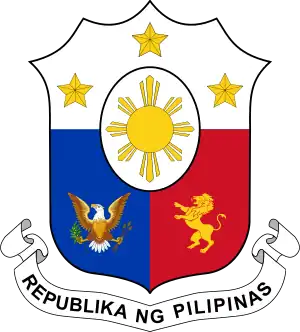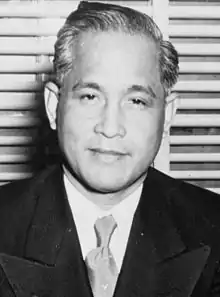1951 Philippine Senate election
A senatorial election was held in the Philippines on November 13, 1951. The election was known as a midterm election as the date when elected candidates take office falls halfway through President Elpidio Quirino's four-year term.
| ||||||||||||||||||||||||||||
8 (of the 24) seats in the Senate, 1 special election for a mid-term vacancy 13 seats needed for a majority | ||||||||||||||||||||||||||||
|---|---|---|---|---|---|---|---|---|---|---|---|---|---|---|---|---|---|---|---|---|---|---|---|---|---|---|---|---|
| ||||||||||||||||||||||||||||
| ||||||||||||||||||||||||||||
Summary
As the Hukbalahap insurgency raged in Central Luzon, Filipinos trooped to the polling booths for the 1951 midterm elections—a referendum on President Quirino, who had won the presidency in his own right two years prior. Despite the political remarriage of the two factions of the Liberal Party, the Quirinistas and Avelinistas, the Quirino administration was still far from popular and had gained notoriety for its inability to rein in corruption and its ineffectual attempts to police lawlessness in the countryside. The Nacionalistas took advantage of the situation and mounted an active campaign to wrest back the Senate from the LP. Led by former President Jose P. Laurel, Quirino’s chief adversary in the 1949 presidential polls, the NP swept all eight Senate seats in contention, the first total victory of the opposition in the Senate. So strong was the rejection of the Quirino administration in 1951 that even LP top honcho, Senate President Mariano Jesus Cuenco, lost his seat. Laurel received the highest number of votes, which was seen as his political rehabilitation and which made him the first and only president, thus far, to have served in the Senate after his presidency.
Felisberto Verano, also a Nacionalista, won the special elections held on the same day to fill the Senate seat vacated by Vice-President Fernando Lopez.
Block voting, established in 1941, was abolished in 1951 with Republic Act No. 599. This would later lead to more fragmented results in most national elections.[1]
Retiring incumbents
Liberal Party
- Melecio Arranz
- Jose Avelino
- Vicente J. Francisco
- Ramon Torres
Mid-term vacancies
- Fernando Lopez, (Liberal, took office as vice president December 30, 1949)
- Vicente Sotto, (Popular Front, died July 16, 1950)
- Tomas Confesor (Nacionalista, died June 5, 1951)
Results
The Nacionalista Party won all eight seats contested in the general election, and the seat contested in the special election.
Former Senate President Mariano Jesús Cuenco was the sole incumbent defeated, while Carlos P. Garcia successfully defended his seat.
Six winners are neophyte Nacionalista senators: Manuel Briones, Francisco Afan Delgado, Jose Locsin, Cipriano Primicias Sr., Gil Puyat and Jose Zulueta.
Nacionalista Jose P. Laurel returned to the Senate after serving from 1925 to 1931.
| 1 | 2 | 3 | 4 | 5 | 6 | 7 | 8 | 9 | 10 | 11 | 12 | 13 | 14 | 15 | 16 | 17 | 18 | 19 | 20 | 21 | 22 | 23 | 24 | |
|---|---|---|---|---|---|---|---|---|---|---|---|---|---|---|---|---|---|---|---|---|---|---|---|---|
| Before election | ‡ | ‡ | ‡ | ‡ | ‡ | ‡^ | ‡^ | ‡^ | ‡ | |||||||||||||||
| Election result | Not up | NP | Not up | |||||||||||||||||||||
| After election | + | + | + | + | + | + | + | + | √ | |||||||||||||||
 |
|---|
|
|
Key:
- ‡ Seats up
- + Gained by a party from another party
- √ Held by the incumbent
- * Held by the same party with a new senator
- ^ Vacancy
Per candidate
| Rank | Candidate | Party | Votes | % | ||
|---|---|---|---|---|---|---|
| 1. | José P. Laurel | Nacionalista | 2,143,452 | 48.8% | ||
| 2. | Gil Puyat | Nacionalista | 1,906,402 | 43.4% | ||
| 3. | Manuel Briones | Nacionalista | 1,774,687 | 40.4% | ||
| 4. | Carlos P. Garcia | Nacionalista | 1,573,095 | 35.8% | ||
| 5. | Francisco Afan Delgado | Nacionalista | 1,534,176 | 34.9% | ||
| 6. | Cipriano Primicias Sr. | Nacionalista | 1,487,159 | 33.9% | ||
| 7. | Jose Locsin | Nacionalista | 1,452,577 | 33.1% | ||
| 8. | Jose Zulueta | Nacionalista | 1,395,095 | 31.8% | ||
| 9. | Jose P. Bengzon | Liberal | 1,277,925 | 29.1% | ||
| 10. | Pio Pedrosa | Liberal | 1,232,791 | 28.1% | ||
| 11. | Teodoro Evangelista | Liberal | 1,210,815 | 27.6% | ||
| 12. | Mariano Jesús Cuenco | Liberal | 1,205,897 | 27.5% | ||
| 13. | Antonio Quirino | Liberal | 1,041,539 | 23.7% | ||
| 14. | Primitivo Lovina | Liberal | 982,601 | 22.4% | ||
| 15. | Juan V. Borra | Liberal | 869,160 | 19.8% | ||
| 16. | Raul Leuterio | Liberal | 850,216 | 19.4% | ||
| 17. | Josefina Phodaca | National Political Party of Women | 431,328 | 9.8% | ||
| 18. | Jose T. Nueno | Independent | 93,246 | 2.1% | ||
| 19. | Leonardo Tenebro | Independent | 2,132 | 0.0% | ||
| 20. | Cesar Bulacan | Independent | 1,371 | 0.0% | ||
| Total turnout | 4,391,109 | 92.4% | ||||
| Total votes | 22,465,664 | N/A | ||||
| Registered voters | 4,754,109 | 100.0% | ||||
| Note: A total of 20 candidates ran for senator. | Source:[2] | |||||
Per party
The seat vacated by Vicente Yap Sotto (Popular Front), who died in 1950, was one of the seats up for election. This also includes the result of the concurrent special election for the seat vacated by Vice President Fernando Lopez in 1949.
 | |||||||||
|---|---|---|---|---|---|---|---|---|---|
| Party | Votes | % | +/– | Seats | |||||
| Up | Before | Won | After | +/− | |||||
| Nacionalista Party | 13,266,643 | 58.81 | +22.48 | 1 | 3 | 9 | 11 | +8 | |
| Liberal Party | 8,764,190 | 38.85 | −13.51 | 5 | 18 | 0 | 13 | −5 | |
| National Political Party of Women | 431,328 | 1.91 | New | 0 | 0 | 0 | 0 | 0 | |
| Independent | 96,749 | 0.43 | −0.00 | 0 | 0 | 0 | 0 | 0 | |
| Vacancy | 3 | 3 | 0 | 0 | −3 | ||||
| Total | 22,558,910 | 100.00 | – | 9 | 24 | 9 | 24 | 0 | |
| Total votes | 4,391,109 | – | |||||||
| Registered voters/turnout | 4,754,307 | 92.36 | |||||||
| Source: Dieter Nohlen; Florian Grotz; Christof Hartmann; Graham Hassall; Soliman M. Santos (15 November 2001). Elections in Asia and the Pacific: A Data Handbook: Volume II: South East Asia, East Asia, and the South Pacific. ISBN 9780199249596. & Julio Teehankee. "Electoral Politics in the Philippines" (PDF). quezon.ph. | |||||||||
Special election
To serve the unexpired term of Fernando Lopez until December 30, 1953.
| Rank | Candidate | Party | Votes | % | |
|---|---|---|---|---|---|
| 1. | Felixberto Verano | Nacionalista | 873,457 | 47.7% | |
| 2. | Cornelio Villareal | Liberal | 609,303 | 33.3% | |
| 3. | Prospero Sanidad | Liberal (Independent) | 223,810 | 12.2% | |
| 4. | Carlos Tan | Liberal (Independent) | 124,975 | 6.8% | |
| Total | 1,831,545 | 100% | |||
References
- Philippine Electoral Almanac. The Presidential Communications Development and Strategic Planning Office. 2013. p. 28. Archived from the original on 2014-04-09.
- Christof Hartmann; Graham Hassall; Soliman M. Santos Jr. (2001). Dieter Nohlen, Florian Grotz and Christof Hartmann (ed.). Elections in Asia and the Pacific Vol. II. Oxford University Press. pp. 185–230. ISBN 0-19-924959-8.

